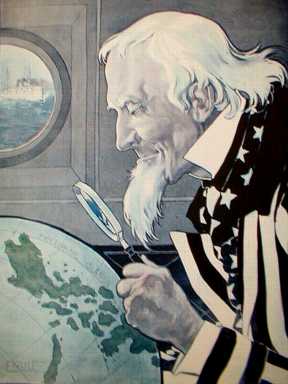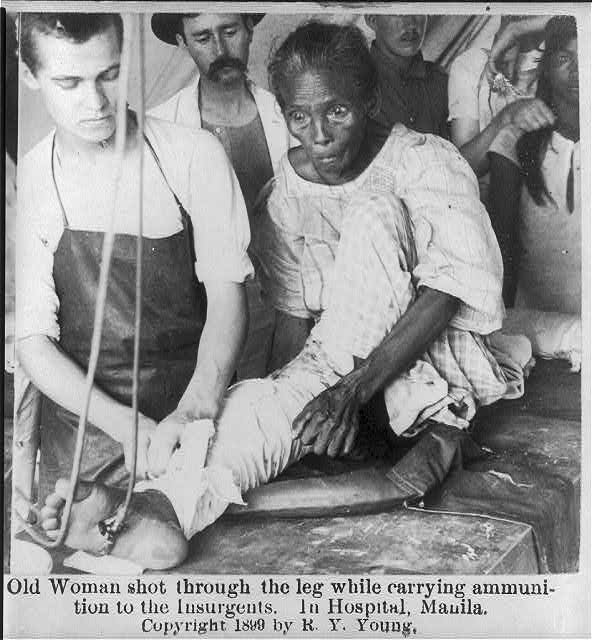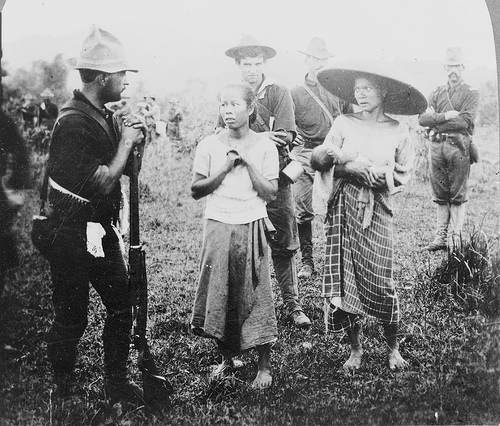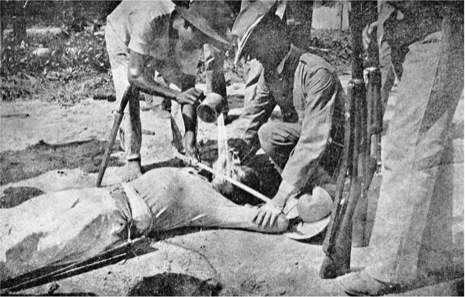Visiting United States Secretary of State Hillary Clinton on Wednesday faced a grilling from Filipino students, as the United States scrambles to counterbalance China's growing power in Asia.
I thought this made it a good time to republish this piece by radical nationalist Joel P Garduce, as background.
----------------------------------------------------------------------------------------------------KEEP THE FIRE by Joel P. Garduce (published in Cebu's The Voice, February 5, 2010, page 6)
Yesterday, February 4, marked the 111th anniversary of the beginning of what still stands as the bloodiest war in the history of the Filipino people. On that day in 1899, open hostilities broke out between invading U.S. troops and soldiers of the first republic in Asia.
.

Uncle Sam at the turn of the 20th century
The war came to be known in history classes and textbooks as the Filipino-American War. It's a misnomer, really. Calling the war this way invokes an image no different from a boxing fight, where protagonists do battle as an end in itself, where there are no aggressors to speak of and no justice to be had. Which is obviously not the case with this war.
It would be more accurate and honest to call it the First Great Patriotic War of the Filipino People. For indeed, it was the first war waged by a newly born nation, the first patriotic war in Asia in fact to defend a republic against an invading army of 20,000 imperial troops (that eventually ballooned to 120,000 throughout the war) intent on taking out so soon a people's freedom freshly gained from centuries-long colonial rule.
It was a war that was as ugly as it could get, a signal tragedy where both the peoples of the Philippines and the US lost their respective republics. On the Filipino side, more than a million Filipinos were killed to regain colonial oppression, most as victims of the barbaric “scorched-earth” policy of the U.S. armed occupation, employed via torture, hamletting, food blockades, and massacres of entire towns, including children.

Wounded granny during the Philippine-American war
On the American side, the victorious U.S. subjugation of a new foreign race consolidated the vicious rule of the robber barons, at a cost of 8,000 American lives and racism, workplace abuse, corruption and oppression running rampant in the homeland. Through systematic indoctrination of succeeding generations, this war, "among the cruelest conflicts in the annals of Western imperialism" as one American author put it, would be gutted out of the historical memory of both Americans and Filipinos.

Filipino civilians being interrogated at the start of American colonial rule.
Well, almost. Were it not for the effort—among others—of Americans of conscience like historian Howard Zinn, who died last week, the outstanding war crimes against the Filipino people may well have been entirely forgotten. Thanks to him and his most popular book, “A People's History of the United States”, arguably the biggest-selling book on the full U.S. history, today's generation in the U.S. has been made aware of a bloody and disdainful history of U.S. empire, and of the continuing epochal class struggle of the American people against it.
“A People's History” was hugely successful. By the time Zinn collapsed fatally from a heart attack last January 27, it had already sold two million copies and gone through six editions since it was first published in 1980 with only 5,000 copies. A 2008 graphic adaptation he co-authored with Mike Konopacki and Paul Buhle, called “A People's History of American Empire”, would go further and boldly parallel the U.S. atrocities against our forefathers more than a hundred years ago to the human rights outrages that attended the U.S.-led war of terrorism ongoing since 9/11.
A 2009 TV docu titled "The People Speak" and based on Zinn's book brought his views to a far-wider audience. Narrated by actor and his former neighbor Matt Damon, it featured readings and performances by various U.S. celebrities, like Viggo Mortensen of the “Lord of the Rings” fame, black actors Morgan Freeman and Danny Glover, Oscar winner Marisa Tomei, and musicians Bruce Springsteen, Eddie Vedder of Pearl Jam, Bob Dylan, Pink, Darryl "DMC" McDaniels, and John Legend. That a nontraditional take of U.S. history would gain much mainstream acceptance and admiration proves that the time for Zinn's progressive standpoint and viewpoint has clearly come.
Zinn's work complements efforts by select Filipino historians to speak historical truth to power. Half a decade before “A People's History” first came out, anti-imperialist author Renato Constantino had already made the case for a people's perspective in writing history with his acclaimed twin history volumes “The Philippines: A Past Revisited” and “The Philippines: The Continuing Past”.
Then there's the seminal “Philippine Society and Revolution” (PSR) written by Professor Jose Maria Sison using his nom de guerre Amado Guerrero. What may well be the most well-known history book in the Philippines, specially among the majority who remain downtrodden, PSR came out a full decade before “A People's History”. (This year marks the 40th year since its publication.) In it, Sison tersely outlined Philippine history and society from a standpoint of an oppressed people daring to make history and change society.

A picture of a “water detail,” reportedly taken in May, 1901, in Sual, the Philippines. “It is a terrible torture,” one soldier wrote. Picture found in “The Water Cure”, Paul Kramer, newyorker.com, Feb 25 2008. Original photograph attributed to Corporal George J. Vennage c/o Ohio State University Rare Books and Manuscripts Library.
Zinn, Constantino and Sison all firmly believe the authentic heroes of history are the unlettered masses and that we ought to champion their hopes and aspirations if we intend to usher in a world of justice and social progress. We are honored to have them remind us all the need to intensely study history to reexamine seemingly unwanted but terribly vital memories, and unearth its lessons pregnant with guidance towards a bright future bereft of ugly and unjust wars, empires of greed, widespread misery and shackled freedoms—a bright future Filipinos, Americans and humankind at large truly deserve. ## Joel Garduce is with the Concerned Artists of the Philippines (CAP). This and previous contributions can be viewed online here. View these historical photos: http://jibrael.blogspot.com/2007/09/philippine-american-war-of-1899-1902.html
Watch this: (for the footages, but ignore some parts of the commentary, which can be wrong)
Watch this, too:
No comments:
Post a Comment